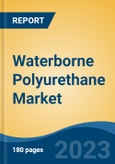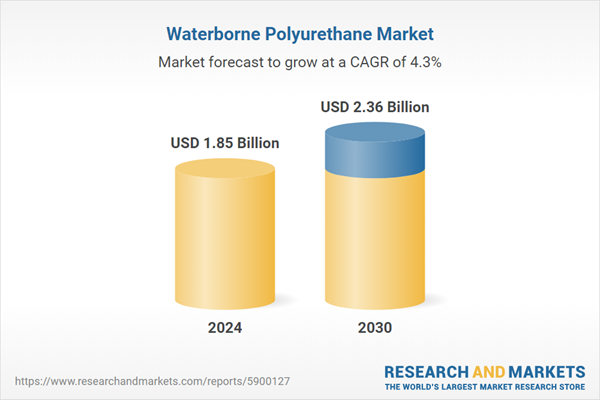Free Webex Call
The Waterborne Polyurethane Market was valued at USD 1.85 Billion in 2024, and is expected to reach USD 2.36 Billion by 2030, rising at a CAGR of 4.32%. Waterborne polyurethane (WPU), known for its versatility and eco-friendly nature, is manufactured by dispersing polyurethane resins in water. It typically includes compounds like hexamethylene diisocyanate, carbamate, and polystyrene, and is noted for its low volatile organic compound (VOC) emissions. These attributes make WPU ideal for use in coatings, adhesives, ink binders, and paints. The building and construction sector continues to fuel market growth, although the COVID-19 pandemic in 2020 temporarily disrupted operations due to raw material shortages and labor constraints. Recovery began in 2021 with the easing of restrictions and renewed activity in the transportation sector, setting a strong foundation for future expansion of the waterborne polyurethane market. Speak directly to the analyst to clarify any post sales queries you may have.
10% Free customizationThis report comes with 10% free customization, enabling you to add data that meets your specific business needs.
Key Market Drivers
Growing Demand of Waterborne Polyurethane from Automotive Industry
Waterborne polyurethane (WPU) is increasingly vital to the automotive sector because of its superior performance characteristics. These include excellent abrasion resistance, strong flexibility, high adhesion, and effective low-temperature durability. WPU is widely utilized in automotive applications such as sealants, coatings, adhesives, and elastomers, with automotive coatings being a particularly significant segment. Rising per capita income and changing consumer preferences toward personal mobility are propelling industry growth. This anticipated increase in passenger car sales is expected to significantly elevate demand for automotive paints and coatings, which serve both aesthetic and protective functions by safeguarding vehicles from environmental factors, corrosion, and daily wear.Key Market Challenges
Volatility in Prices of Raw Materials
Waterborne polyurethane production depends heavily on raw materials derived from crude oil, especially isocyanates and polyols, including ethylene carbonate, which are prone to significant price fluctuations. These costs are tightly linked to the volatile nature of crude oil prices, influenced by global events such as geopolitical tensions, natural calamities, economic disturbances, and supply changes by oil-producing countries. When oil prices surge, production costs for WPU also rise, thereby increasing overall manufacturing expenses. Conversely, during periods of price decline, manufacturers may face delays in adjusting their pricing due to existing stock levels or contractual obligations, leading to reduced competitiveness and squeezed profit margins.Key Market Trends
Increased Advancements in Formulations
Despite its established advantages like flexibility, adhesion, and abrasion resistance, continuous innovation is enhancing the capabilities of waterborne polyurethane (WPU). Researchers and producers are striving to improve these properties to broaden the scope of WPU applications. The trend is shifting from traditional 1K solventborne polyurethane coatings used in wood flooring to 2K waterborne polyurethane formulations, driven by stricter VOC regulations and growing preference for low-odor products. These newer formulations offer benefits such as greater durability, stain resistance, maintenance ease, gloss customization, and improved adhesion to reactive surfaces, ultimately boosting their visual appeal and performance across diverse industries.Key Market Players
- The 3M Company
- Henkel AG & Co. KGaA
- The Dow Chemical Company
- Bayer Material Science Pvt Ltd
- PPG Industries Inc.
- BASF SE
- The Sherwin-Williams Company
- RPM International Inc.
- Lamberti SpA
- Covestro AG
Report Scope:
In this report, the Global Waterborne Polyurethane Market has been segmented into the following categories, in addition to the industry trends which have also been detailed below:Waterborne Polyurethane Market, By Product Type:
- Anionic PUDs
- Cationic PUDs
- Non-Ionic PUDs
- Single-Component Polyurethane
- Two-Component Polyurethane
- Others
Waterborne Polyurethane Market, By End User:
- Building & Construction
- Automotive
- Electronics & Electricals
- Textile
- Packaging
- Others
Waterborne Polyurethane Market, By Region:
- North America
- United States
- Canada
- Mexico
- Europe
- France
- United Kingdom
- Italy
- Germany
- Spain
- Asia Pacific
- China
- India
- Japan
- Australia
- South Korea
- South America
- Brazil
- Argentina
- Colombia
- Middle East & Africa
- South Africa
- Saudi Arabia
- UAE
Competitive Landscape
Company Profiles: Detailed analysis of the major companies present in the Global Waterborne Polyurethane Market.Available Customizations:
With the given market data, the publisher offers customizations according to a company's specific needs. The following customization options are available for the report.Company Information
- Detailed analysis and profiling of additional market players (up to five).
This product will be delivered within 1-3 business days.
Table of Contents
1. Product Overview
2. Research Methodology
3. Executive Summary
4. Global Waterborne Polyurethane Market Outlook
5. Asia Pacific Waterborne Polyurethane Market Outlook
6. Europe Waterborne Polyurethane Market Outlook
7. North America Waterborne Polyurethane Market Outlook
8. South America Waterborne Polyurethane Market Outlook
9. Middle East and Africa Waterborne Polyurethane Market Outlook
10. Market Dynamics
11. Market Trends & Developments
13. Porter’s Five Forces Analysis
14. Competitive Landscape
Companies Mentioned
- The 3M Company
- Henkel AG & Co. KGaA
- The Dow Chemical Company
- Bayer Material Science Pvt Ltd
- PPG Industries Inc.
- BASF SE
- The Sherwin-Williams Company
- RPM International Inc.
- Lamberti SpA
- Covestro AG
Table Information
| Report Attribute | Details |
|---|---|
| No. of Pages | 185 |
| Published | July 2025 |
| Forecast Period | 2024 - 2030 |
| Estimated Market Value ( USD | $ 1.85 Billion |
| Forecasted Market Value ( USD | $ 2.36 Billion |
| Compound Annual Growth Rate | 4.3% |
| Regions Covered | Global |
| No. of Companies Mentioned | 10 |









